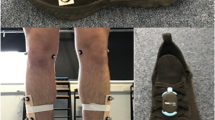Abstract
Orthotic insoles are used to correct abnormal or irregular walking in children and adults, as well as for physical training and sports. The influence of orthotic insole materials on the ground reaction force and friction during walking has been studied. It has been shown that the biomechanical gait parameters can be optimized using insoles that consist of different materials with a low inflexibility in the heel area and a high coefficient of friction in the front part.
Similar content being viewed by others
References
Vasilescu, A.M., Micu, A.C., and Bogatu, L., Experimental determinations of the round reaction force depending on the characteristics of sole materials and ground surface, UPB Sci. Bull., Ser. D,2011, vol. 73, pp. 1454–2358.
Ottobock Materials, http://doc.ottobock.es/protesica/Materiales_2013.pdf 3. Leber, C. and Evanski, P.M., A comparison of shoe insole materials in plantar pressure relief, Prosth. Orthotics Int., 1986, no. 10, pp. 135–138.
Nigg, B.M. and Morlock, M., The influence of lateral heel flare of running shoes on pronation and impact forces, Med. Sci. Sports Exercise’s Latest.,1987, vol. 19, pp. 294–302.
Ruano, C., Chalambaga, E.T., Renshaw, D., and Powell, D., The effects of tempur insoles on ground reaction forces and loading rates in running, Int. J. Exercise Sci.,2009, vol. 2, no. 3, pp. 186–190.
Kulcu, D.G., Yavuzer, G., Sarmer, S., and Ergin, S., Immediate effects of silicone insoles on gait pattern in patients with flexible flatfoot, Foot Ankle Int.,2007, vol. 28, pp. 1053–1056.
Leung, A.K.L., Mak, A.F.T., and Evans, J.H., Biomechanical gait evaluation of the immediate effect of orthotic treatment for flexible flat foot, J. Int. Soc. Prosth. Orthotics,1998, vol. 22, pp. 25–34.
Derler, S., Huber, R., Feuz, H.-P., and Hadad, M., Influence of surface microstructure on the sliding friction of plantar skin against hard substrates, Wear,2009, vol. 267, pp. 1281–1288.
Derlyatka, M., Ignatovskii, M.I., and Lashkovskii, V.V., Biomekhanika i korrektsiya disfunktsii stop (Biomechanics and Footstep Disfunction Correction), Sviridenok, A.I. and Lashkovskii, V.V., Eds., Grodno: Grodn. Gos. Ubiv., 2009.
Pauk, J. and Griskevicius, J., Ground reaction force and support moment in typical and flat-feet children, Mechanika,2011, vol. 17, pp. 93–96.
Author information
Authors and Affiliations
Additional information
Original Russian Text © J. Pauk, J. Tolstoj-Sienkiewicz, M. Ihnatouski, T. Kuzmierowski, E. Chojnowski, 2015, published in Trenie i Iznos, 2015, Vol. 36, No. 4, pp. 415–420.
About this article
Cite this article
Pauk, J., Tolstoj-Sienkiewicz, J., Ihnatouski, M. et al. Influence of insole materials on friction and ground reaction force during gait. J. Frict. Wear 36, 319–323 (2015). https://doi.org/10.3103/S1068366615040133
Received:
Published:
Issue Date:
DOI: https://doi.org/10.3103/S1068366615040133




